Blue hydrangeas are a stunning addition to any garden, offering vibrant hues that can transform your outdoor space into a serene paradise. With their lush blooms and versatile varieties, blue hydrangeas have become a favorite among gardeners and landscape enthusiasts alike. In this comprehensive guide, we’ll explore seven exquisite blue hydrangea varieties that are sure to brighten your garden and captivate your senses.
Understanding Blue Hydrangeas
Before diving into the specific varieties, it’s essential to understand what makes blue hydrangeas unique. Unlike other hydrangea colors, blue hydrangeas are not naturally blue. Their striking blue hue is a result of soil pH levels, which influence the availability of aluminum ions that the plants absorb. Acidic soils (pH below 6) encourage blue blossoms, while alkaline soils (pH above 7) result in pink or white flowers. By adjusting your garden’s soil pH, you can cultivate the beautiful blue blooms that make hydrangeas so enchanting.
The Science Behind Blue Hydrangeas
Blue hydrangeas owe their color to the presence of aluminum ions in the soil. When the soil is acidic, these ions become more available to the plant, resulting in the production of blue pigments in the flowers. Gardeners can manipulate soil pH by adding amendments like aluminum sulfate to create the ideal conditions for blue hydrangea blooms. Understanding this relationship is key to successfully growing and maintaining blue hydrangeas in your garden.
Benefits of Blue Hydrangeas
- Aesthetic Appeal: The vibrant blue flowers add a splash of color to gardens, making them a focal point in any landscape design.
- Versatility: Blue hydrangeas can thrive in various garden settings, from cottage gardens to modern landscapes.
- Symbolism: Blue hydrangeas symbolize grace, abundance, and beauty, making them a meaningful addition to gardens and floral arrangements.
1. Hydrangea macrophylla (Bigleaf Hydrangea)
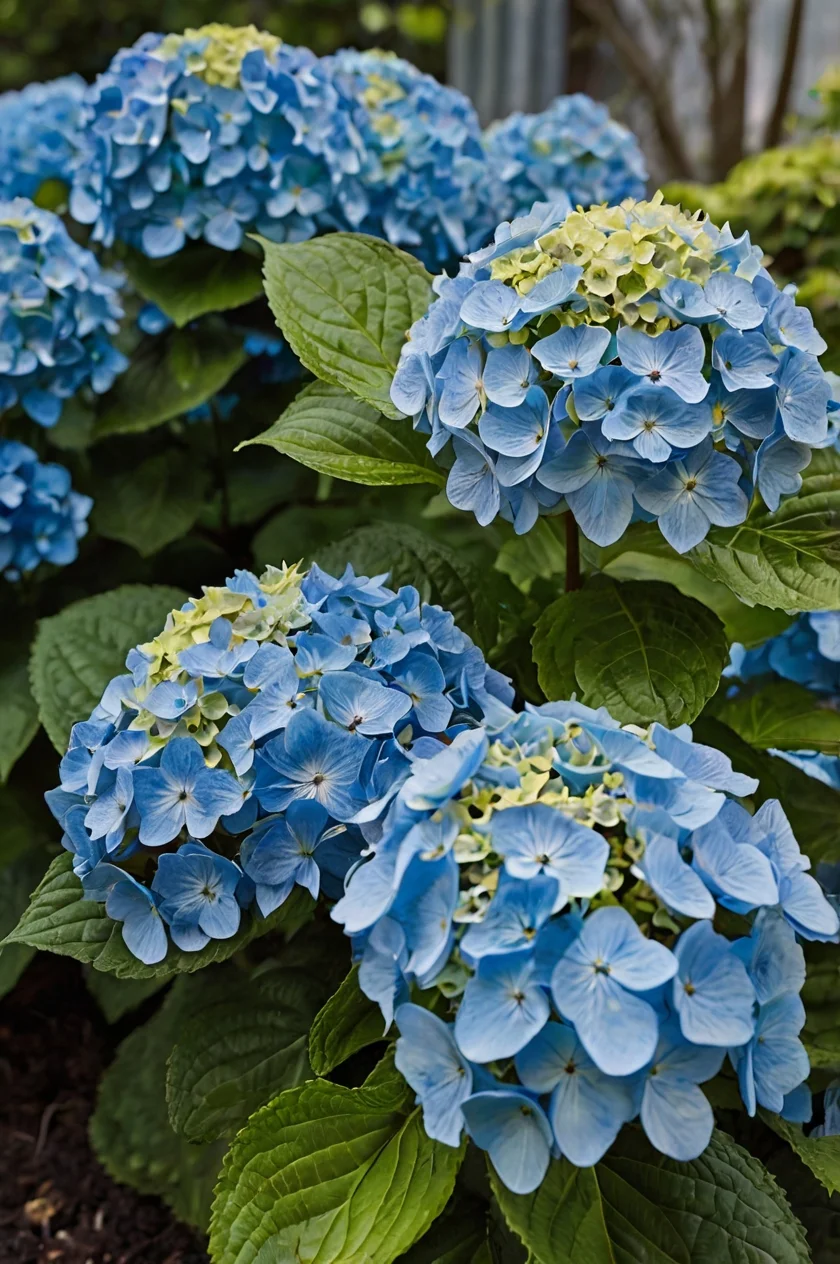
Hydrangea macrophylla, commonly known as Bigleaf Hydrangea is one of the most well-known blue varieties of hydrangea. Renowned for its large, lush blooms, this variety is a staple in many gardens due to its striking appearance and adaptability.
Growing Conditions and Care Tips
Bigleaf Hydrangeas thrive in partially shaded areas with well-drained, acidic soil. They require consistent moisture, especially during the blooming season. Pruning should be performed following flowering to stimulate new growth and keep the shape of the plant.
Popular Blue Varieties
- Blue Wave: Known for its vibrant blue flowers and robust growth, Blue Wave is a favorite among gardeners seeking a reliable blue hydrangea.
- Blue Diamond: This variety offers deep blue blossoms with a compact growth habit, making it ideal for smaller gardens or container planting.
Pros of Bigleaf Hydrangeas
- Ease of Growth: Bigleaf Hydrangeas are relatively easy to grow with proper care.
- Versatile Aesthetics: Their large blooms make them suitable for various garden styles and landscape designs.
2. Hydrangea arborescens (Smooth Hydrangea)
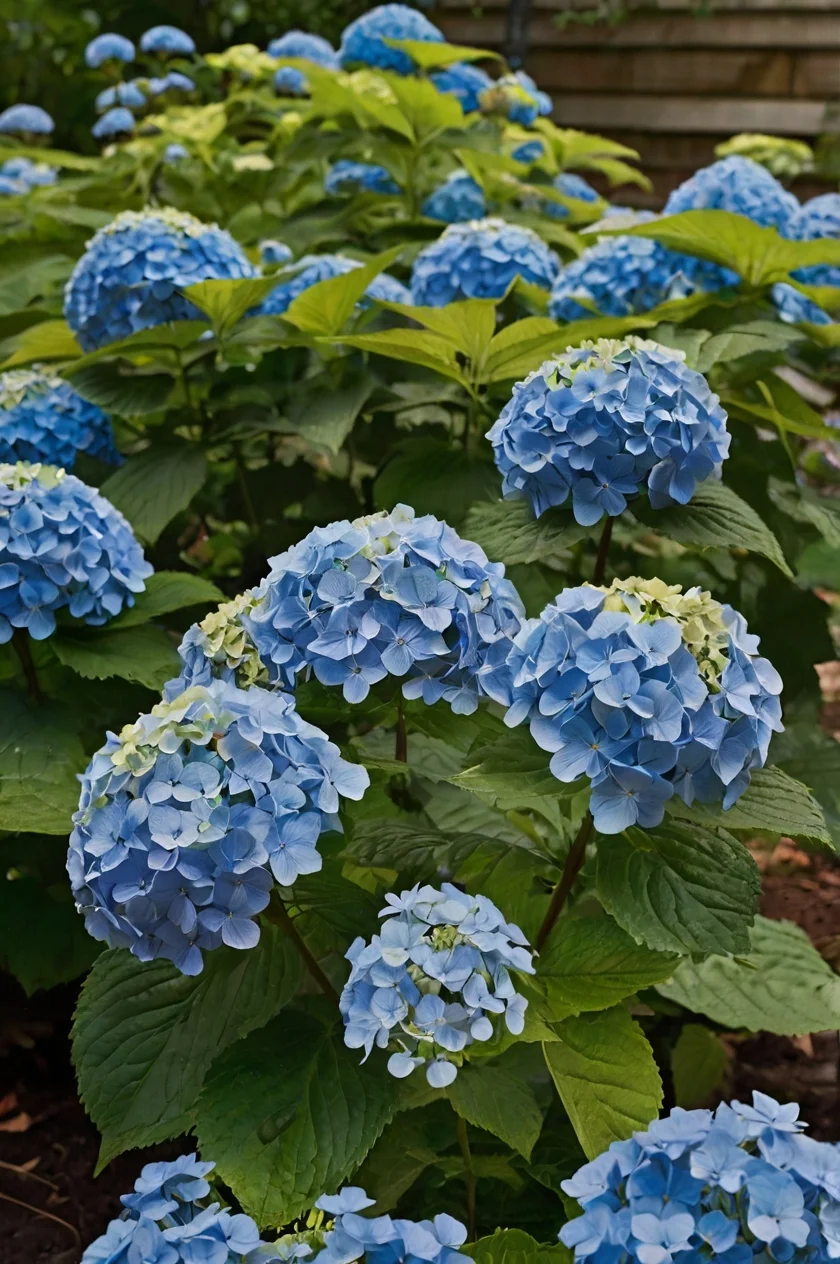
Hydrangea arborescens, or Smooth Hydrangea, is another beautiful blue hydrangea variety. Unlike Bigleaf Hydrangeas, Smooth Hydrangeas have smooth stems and more subtle, rounded blooms.
Ideal Growing Conditions
Smooth Hydrangeas prefer full sun to partial shade and thrive in moist, well-drained soil. They are hardy plants, capable of withstanding a range of climates, making them a versatile choice for many gardeners.
Notable Blue Varieties
- Annabelle: While typically white, Annabelle can produce blue blooms under the right soil conditions, adding a delicate charm to gardens.
- Pia: Known for its pure white flowers, Pia can turn blue with soil amendments, offering a graceful presence in any garden.
Advantages of Smooth Hydrangeas
- Hardiness: Smooth Hydrangeas are more tolerant of different climates compared to other hydrangea types.
- Low Maintenance: They need minimum maintenance, making them perfect for novice as well as experienced gardeners.
3. Hydrangea paniculata (Panicle Hydrangea)
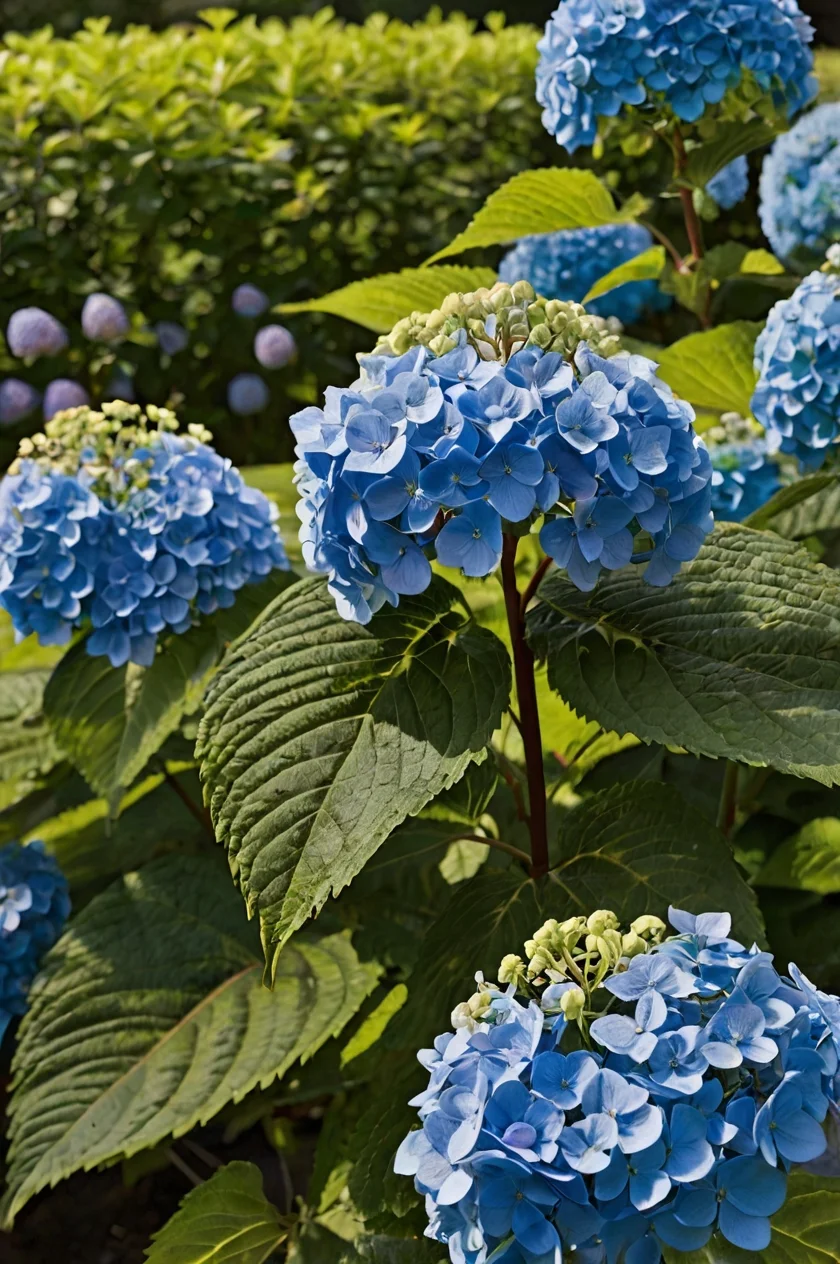
Hydrangea paniculata, or Panicle Hydrangea, is celebrated for its cone-shaped flower clusters. While traditionally associated with white or pink blooms, certain varieties can produce stunning blue flowers when grown in acidic soil.
Cultivation and Maintenance
Panicle Hydrangeas thrive in full sun and well-drained, acidic soil. They are known for their vigorous growth and ability to withstand colder climates, making them a robust choice for various garden settings.
Top Blue Varieties
- Limelight: This variety features large, lime-green flowers that can turn blue with soil pH adjustments.
- Pink Pixie: Typically pink, Pink Pixie can produce blue blooms, offering a vibrant contrast in garden arrangements.
Benefits of Panicle Hydrangeas
- Dramatic Impact: The conical shape of Panicle Hydrangeas adds a dramatic focal point to gardens.
- Cold Hardy: These hydrangeas are more resistant to cold weather, ensuring beautiful blooms even in harsher climates.
4. Hydrangea serrata (Mountain Hydrangea)
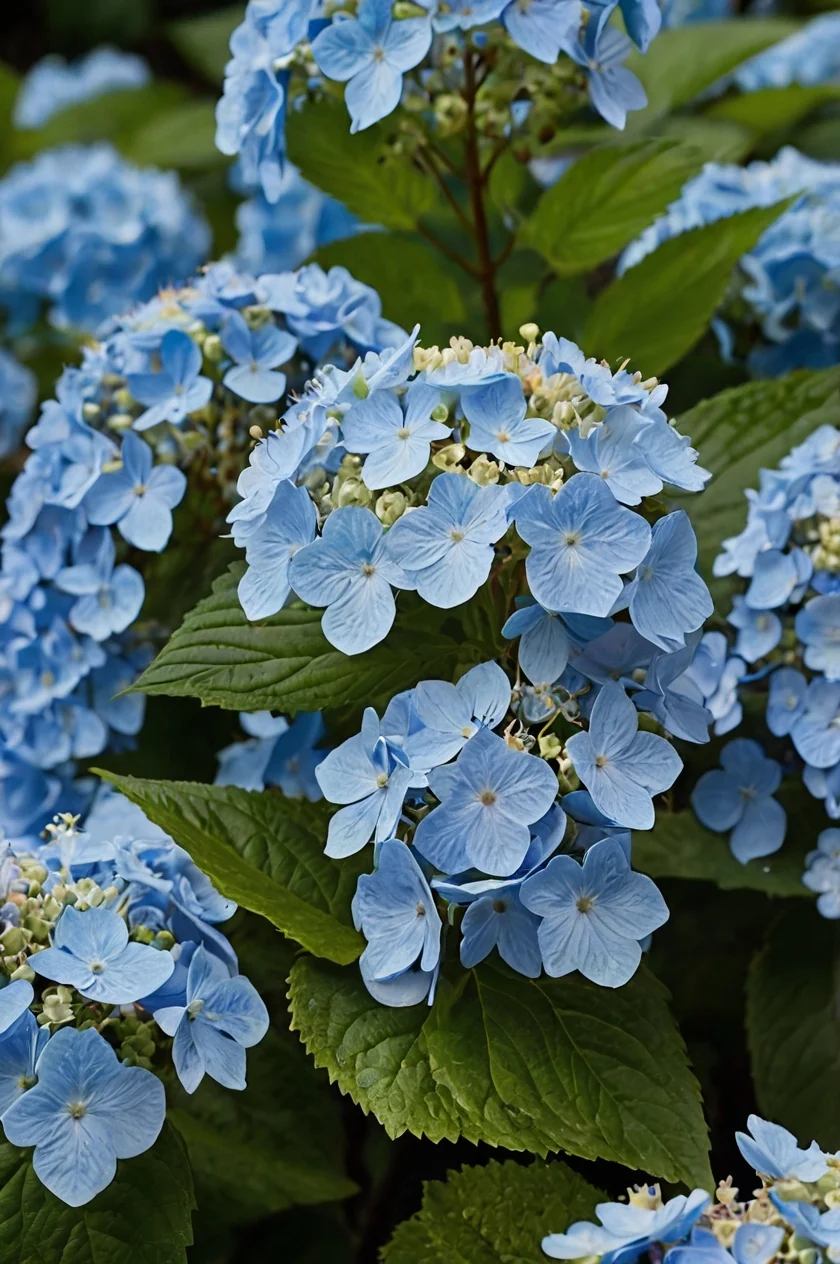
Hydrangea serrata, or Mountain Hydrangea, is a compact and elegant blue hydrangea variety. Known for its delicate, serrated leaves and graceful blooms, it is perfect for smaller gardens and container planting.
Growing Requirements
Mountain Hydrangeas prefer partial shade and well-drained, acidic soil. They are hardy plants that can tolerate cooler climates, making them suitable for mountainous regions and temperate gardens.
Recommended Blue Varieties
- Bluebird: This variety showcases stunning blue blooms and a compact growth habit, ideal for adding color to limited spaces.
- Little Lime: Known for its small, vibrant blue flowers, Little Lime is perfect for enhancing patios and balconies.
Pros of Mountain Hydrangeas
- Compact Size: Their smaller stature makes them ideal for gardens with limited space.
- Cool Climate Tolerance: Mountain Hydrangeas can thrive in cooler environments, expanding their versatility.
5. Hydrangea quercifolia (Oakleaf Hydrangea)
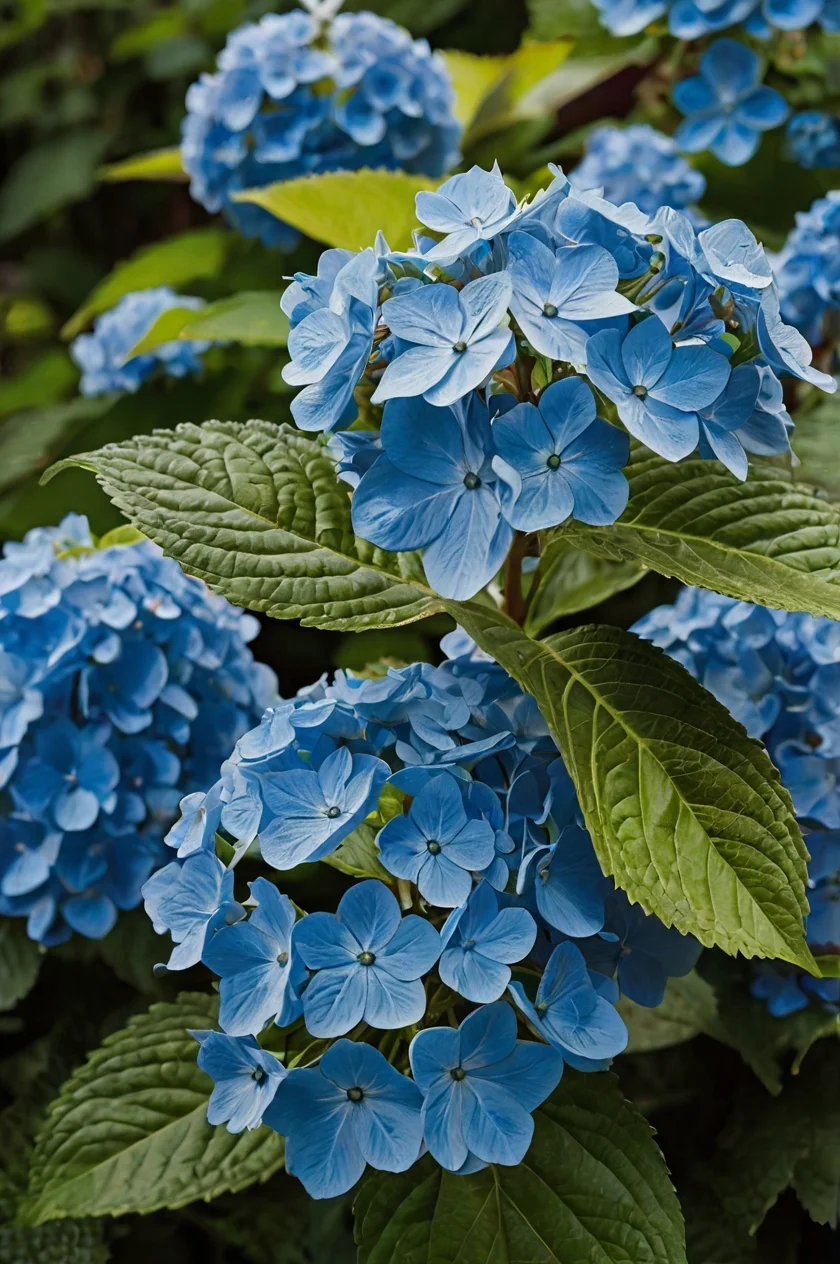
Hydrangea quercifolia, or Oakleaf Hydrangea, is renowned for its unique oak-shaped leaves and striking blue flowers. This variety adds both color and texture to gardens, creating a dynamic visual appeal.
Growing Conditions
Oakleaf Hydrangeas prefer partial shade and well-drained, acidic soil. They are tough plants that can endure a variety of weather conditions, making them a resilient choice for many gardens.
Blue Variety Examples
- Alice: Known for its deep blue blossoms and oak-like foliage, Alice is a standout variety in any garden setting.
- Natchez: While typically white, Natchez can produce blue blooms with proper soil pH, offering a versatile addition to landscape designs.
Advantages of Oakleaf Hydrangeas
- Unique Foliage: The oak-shaped leaves provide a distinct contrast to the vibrant blue flowers, enhancing garden aesthetics.
- Landscape Versatility: Oakleaf Hydrangeas can be used as focal points or integrated into mixed borders and woodland gardens.
6. Hydrangea × myrtifolia (Myrtle-leaf Hydrangea)
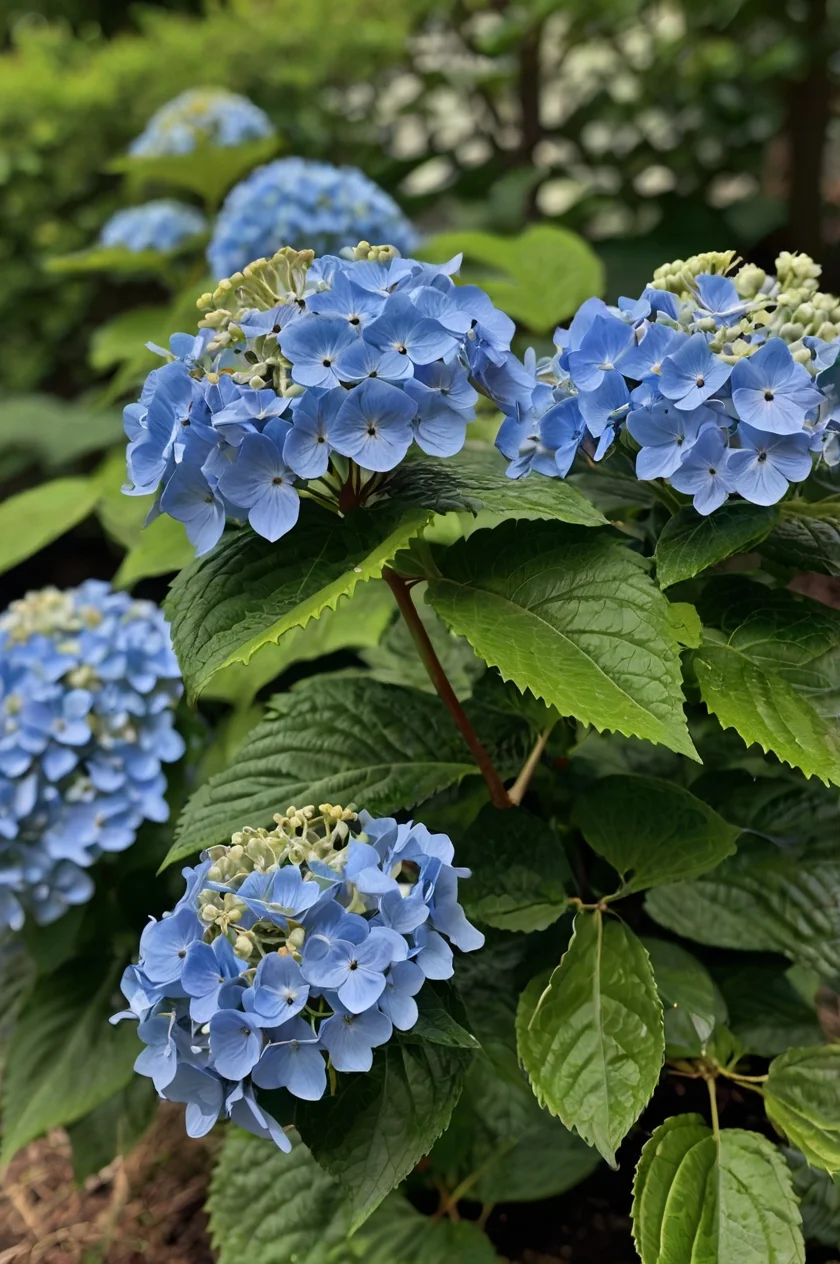
Hydrangea × myrtifolia, or Myrtle-leaf Hydrangea, is prized for its glossy, myrtle-like leaves and elegant blue flowers. This hybrid plant combines the best characteristics of its parent species and results in a stunning and sturdy plant.
Popular Blue Varieties
- Myrtle Blue: True to its name, Myrtle Blue features stunning blue blooms and glossy foliage, making it a favorite among gardeners.
- Silver Orb: While typically silver-green, Silver Orb can produce blue flowers under the right soil conditions, adding a unique touch to gardens.
Growing Tips
Myrtle-leaf Hydrangeas thrive in full sun to partial shade and prefer well-drained, acidic soil. Regular watering and occasional pruning help maintain their shape and promote abundant blooms.
Benefits of Myrtle-leaf Hydrangeas
- Long-lasting Blooms: These hydrangeas offer extended blooming periods, providing continuous color throughout the season.
- Elegant Appearance: The combination of glossy leaves and vibrant blue flowers creates a sophisticated garden presence.
7. Hydrangea ‘Endless Summer’
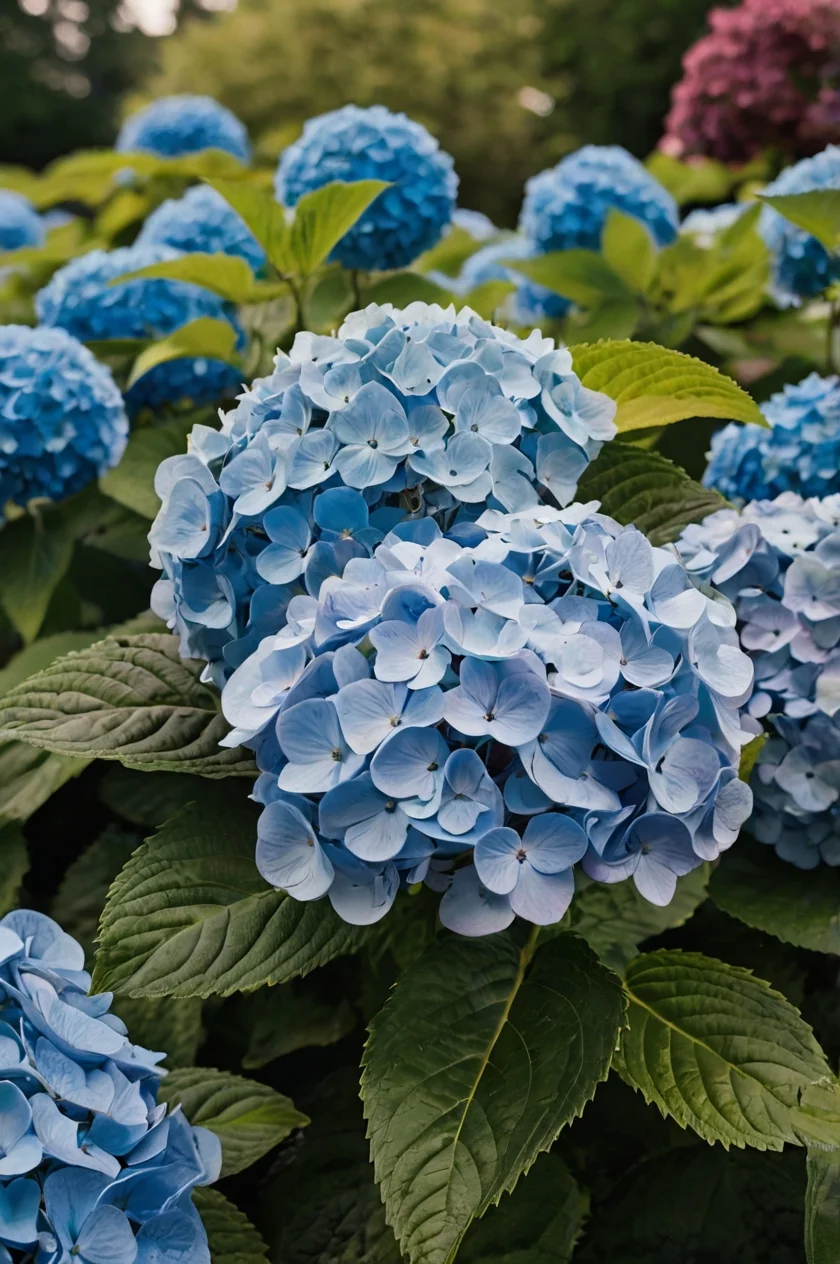
Hydrangea ‘Endless Summer’ is a popular blue hydrangea variety known for its continuous blooming throughout the growing season. This variety is celebrated for its reliability and vibrant blue flowers, making it a top choice for gardeners seeking consistent color.
Unique Selling Points
- Reblooms Seasonally: Endless Summer Hydrangeas bloom multiple times from spring to fall, ensuring a prolonged display of blue flowers.
- Vibrant Blue Display: The deep blue blossoms are a striking addition to any garden, providing a constant source of beauty.
Growing and Maintenance Tips
Endless Summer Hydrangeas thrive in full sun to partial shade and well-drained, acidic soil. Regular watering and periodic fertilization promote healthy growth and vibrant blooms. Pruning should be done after the last bloom to encourage new flower production.
Advantages of Endless Summer Hydrangeas
- Reliable Blooming: Gardeners can count on Endless Summer Hydrangeas to provide continuous blue blooms throughout the season.
- Versatile Placement: Suitable for various garden settings, including borders, containers, and mixed flower beds.
Conclusion
Blue hydrangeas are a captivating addition to any garden, offering vibrant color and versatile beauty. From the robust Hydrangea macrophylla to the elegant Hydrangea × myrtifolia, each variety brings its unique charm and characteristics. By understanding the specific growing conditions and care requirements, you can cultivate these stunning blue hydrangeas to brighten your outdoor space and create a serene, picturesque garden.
Whether you’re a seasoned gardener or just starting, incorporating blue hydrangeas into your garden design can enhance the overall aesthetic and provide a continuous source of beauty throughout the growing season. So, which blue hydrangea variety will you choose to transform your garden into a vibrant paradise? Start planting today and enjoy the timeless beauty of blue hydrangeas.
Additional Resources
Enhance your journey to cultivating stunning blue hydrangeas with these valuable resources. Whether you’re a seasoned gardener or just starting, these tools, guides, and communities will support you in creating a vibrant and thriving garden.
Books and Guides
- “Hydrangeas: The Essential Guide” by David Austin
- A comprehensive resource covering various hydrangea species, including detailed care instructions and design inspiration.
- “The Hydrangea Handbook” by Karen Tucker
- Offers in-depth information on growing, pruning, and maintaining hydrangeas to achieve the most vibrant blooms.
- “Gardening with Hydrangeas” by Carole Bryant
- Provides practical tips and creative ideas for incorporating hydrangeas into your garden landscape.
Tools and Products
- Soil pH Test Kit
- Essential for monitoring and adjusting soil acidity to ensure optimal blue hydrangea blooms. Available at most garden centers or online retailers.
- Aluminum Sulfate
- A soil amendment used to lower pH levels, promoting the vibrant blue coloration of hydrangea flowers.
- Mulch and Compost
- High-quality organic mulch and compost improve soil structure and fertility, supporting healthy hydrangea growth.
Online Communities and Forums
- Reddit Gardening Community
- Join discussions, ask questions, and share your experiences with fellow gardeners to gain insights on growing blue hydrangeas.
Frequently Asked Questions (FAQs)
How Can I Achieve Blue Hydrangea Blooms in My Garden?
To cultivate blue hydrangea blooms, it’s essential to create acidic soil conditions (pH below 6). You can achieve this by adding soil amendments such as aluminum sulfate or acidic compost to lower the pH. Regularly testing your soil’s pH will help you maintain the ideal environment for vibrant blue flowers. Additionally, ensure your hydrangeas receive adequate water and are planted in partially shaded areas to promote healthy growth and stunning blue blooms.
What Are the Best Blue Hydrangea Varieties for Beginners?
For novice gardeners, Hydrangea macrophylla (Bigleaf Hydrangea) and Hydrangea arborescens (Smooth Hydrangea) are excellent choices. Bigleaf Hydrangeas are popular for their large, vibrant blue flowers and relatively easy care requirements. Smooth Hydrangeas are hardy, low-maintenance, and adaptable to various climates, making them ideal for those new to growing blue hydrangeas. Both varieties respond well to soil pH adjustments, allowing beginners to achieve beautiful blue blooms with proper care.
Do Blue Hydrangeas Require Special Maintenance Compared to Other Hydrangeas?
Blue hydrangeas share similar maintenance needs with other hydrangea varieties, but achieving and maintaining their blue color does require specific attention to soil pH. Regularly monitor and adjust the soil acidity to ensure optimal blue blooms. Pruning should be done after flowering for varieties like Hydrangea macrophylla to encourage new growth. Additionally, providing consistent watering, mulching to retain moisture, and protecting plants from extreme weather conditions will help maintain the health and beauty of your blue hydrangeas.
Can I Grow Blue Hydrangeas in Containers or Small Gardens?
Yes, many blue hydrangea varieties are well-suited for container gardening and smaller garden spaces. Hydrangea serrata (Mountain Hydrangea) and compact varieties of Hydrangea × myrtifolia (Myrtle-leaf Hydrangea) are excellent choices for containers. When growing blue hydrangeas in pots, ensure they have sufficient drainage and use acidic potting mix to maintain the desired soil pH. Regular watering and periodic feeding with a balanced fertilizer will support healthy growth and vibrant blue flowers, even in limited spaces.
How Long Do Blue Hydrangea Blooms Last, and When Is the Best Time to Plant Them?
Blue hydrangea blooms typically last from late spring through early fall, depending on the variety and growing conditions. Hydrangea ‘Endless Summer’ is renowned for its prolonged blooming period, providing continuous blue flowers throughout the growing season. The best time to plant blue hydrangeas is in the spring or early fall when the weather is mild, allowing the plants to establish their root systems before the heat of summer or the cold of winter. Proper planting time, combined with consistent care, will ensure your blue hydrangeas bloom beautifully for many months.





GIPHY App Key not set. Please check settings